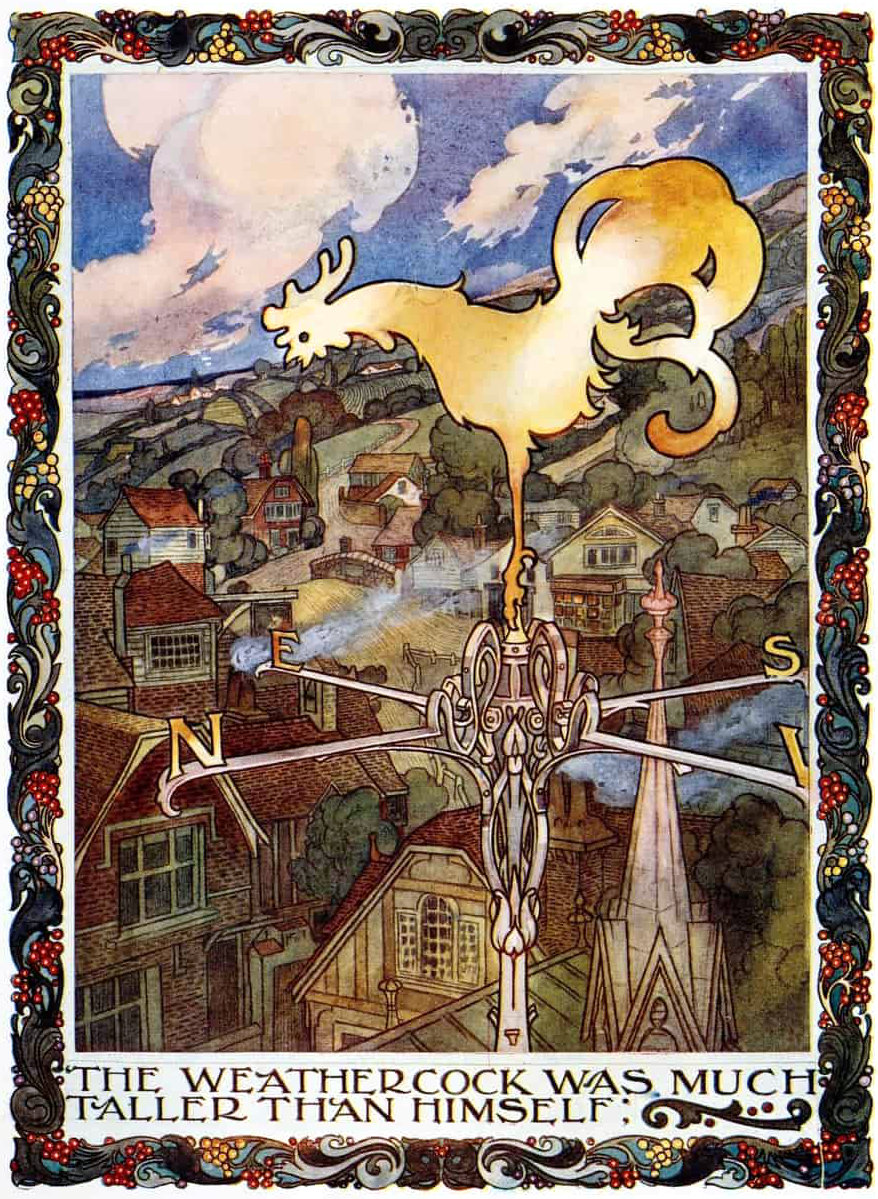The cardinal directions — north, east, south and west — have quite different associations in each culture around the world. This article focuses on the Western literary tradition, which is heavily influenced by the Bible. One commonality across ancient traditions: cardinal directions are in some way sacred. Many traditions have rules and guidelines around which direction to pray, sleep and be buried.
Not all cultures have those same four basic points of north, east, south and west. For example, the Zuni are Native American Pueblo peoples native to the Zuni River valley. The Zuni tradition has six points: the Western four plus one above and another below. Each direction has an animal guard:
- The mountain lion guards the North.
- The bear guards the West.
- The badger guards the South.
- The wolf guards the East.
- The eagle guards the Upper Dimension or the Sky.
- The mole guards the Lower Regions or the Earth.
East Asian cultures also connect animals of the zodiac to their cardinal directions: Rat for north, rabbit for east, horse for south, rooster for west. By coincidence, the Christian tradition also uses the rooster on weather vanes, not because of any particular association with the west. Pope Gregory the first said that the cock (rooster) “was the most suitable emblem of Christianity”, being “the emblem of St Peter”. (Saint Peter is the patron saint of travellers, who need a sense of direction to get them home safely.)
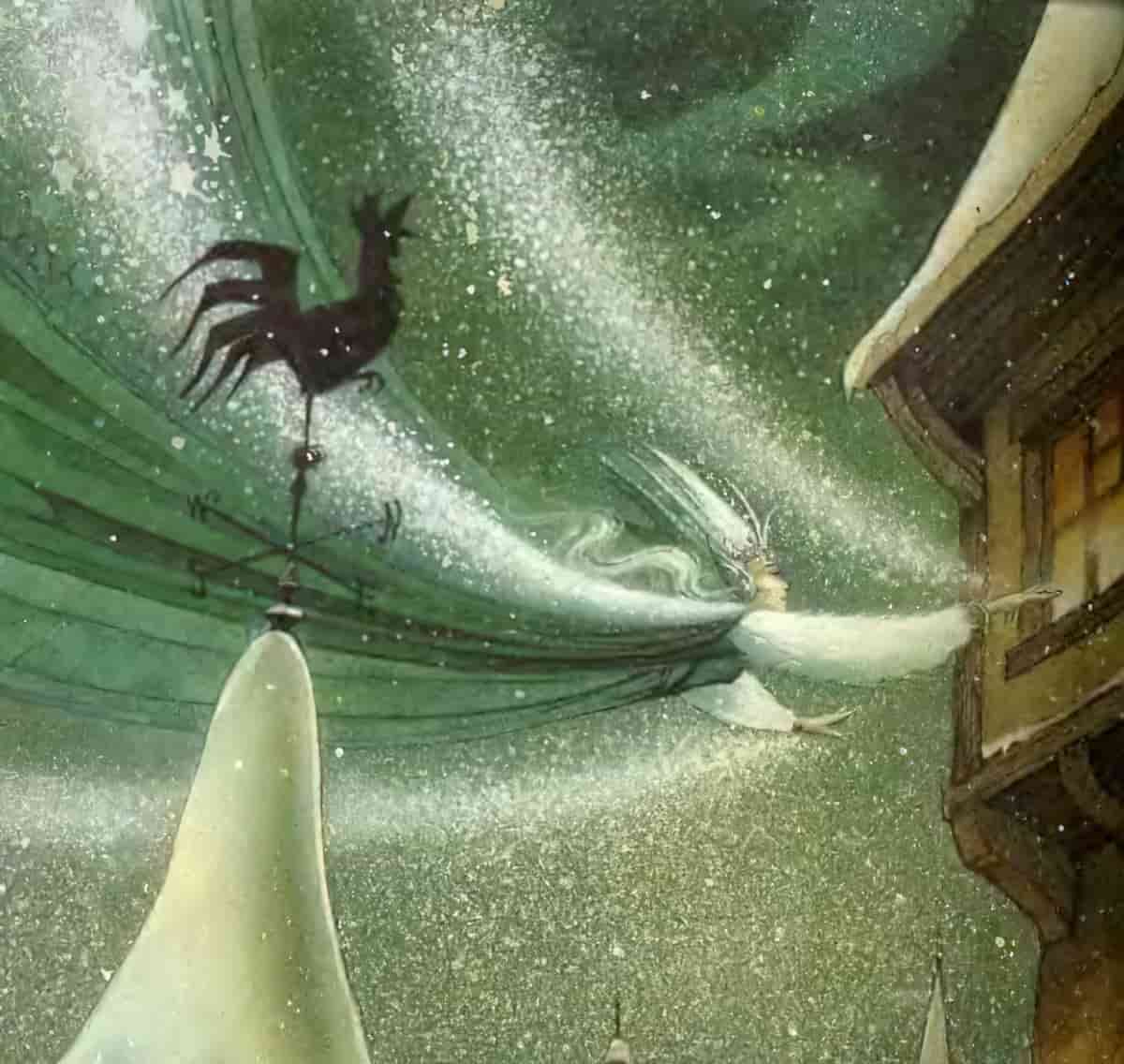
Australian Aboriginal cultures use the stars to navigate. This is a complex and ancient system and involves connecting stars to features of the landscape. To take one example of how Australian Aboriginal cultures conceptualise cardinal direction, the Warlpiri people of central Australia connect directions as follows:
- North = law
- South = ceremony
- West = language
- East = skin
In the centre of the compass is ‘country’ (here).
In Aotearoa (New Zealand), Māori people connected cardinal direction to the names of various winds. First, the Māori names for cardinal direction:
- North = Raki
- South = tonga
- West = uru
- East = rawhiti or rawhitiroa
Each tribe has its own highly individual way of connecting wind to direction. Some of these names can be seen in New Zealand place names, for example Paeroa means south-east among the Ngati-Porou.
And according to the Moriori compass, south-east is Tonga-riro. Tongariro (as in Tongariro National Park) derives from the words ‘tonga’ meaning ‘south east wind’ and ‘riro’ meaning ‘carried away’. North wind is tokelau. These concepts hold steady across many Polynesian languages.
It is not unusual across cultures to link direction to atmospheric conditions, especially wind. (Around 19% of all languages connect north and south directionality to wind. Far fewer than that connect east and west to wind.)
East Polynesians probably brought with them to Aotearoa the concept of a sun-wind compass.
WHERE DO CARDINAL DIRECTION TERMS COME FROM?
Historical linguists discovered parallels between two big language groups: Indo-European and Polynesian.
In Indo-European languages, the words for East and West come from words such as: dawn, morning, to rise, evening, going down. These all relate to the rising or setting of the sun. Same goes for some of the Polynesian languages. This is not the surprising part. Identifying east and west by connecting it to the sun is the most ubiquitous way cultures developed terms for cardinal points.
Several Indo-European language, as well as several Polynesian languages share this surprising thing in common: Terms for north and/or south come from the terms for left and/or right (side). This leads to languages in which the word for left also means north. The word for right also means south.
In most cases, historical linguists have no trouble determining where the words for direction come from. For that reason, they know that the words for the cardinal directions in Indo-European and Polynesian languages are comparatively recent. For example, there’s no evidence these words existed in Proto-Indo-European languages. (Proto-Indo-European was spoken as a single language from 4500 BC to 2500 BC during the Late Neolithic to Early Bronze Age, though estimates vary by more than a thousand years.) When other language families are studied, we learned that the words for cardinal direction are equally new across all cultures.
Why did people living in ancient times not need words to describe cardinal direction?
When humans lived in small-scale societies, but cardinal points only come in useful over a larger distance. Early humans had intimate knowledge of their own surroundings. In fact, pre-colonized cultures had an impressive knowledge of their own surroundings until time of contact with colonizers. Even nomadic cultures had little reason to use cardinal directions because their detailed knowledge of landscape and skyscape simply extended further. If they needed to explain where something was to another person, they described features of landscape. Phrases such as ‘on the other side of the lagoon’ or ‘beyond the mountain’ sufficed.
Cardinal points become useful once humans were highly mobile, venturing past their own high-knowledge arenas. Now they needed knowledge of pan-geographic, fixed directions (north, south, east, west etc.)
THE MULTIVALENT SYMBOLISM OF CARDINAL DIRECTION
In the Bible, the cardinal directions tend to have both good and evil associations at once. This is to do with the idea that you find evil everywhere, all over the place.
SYMBOLISM OF THE NORTH
Modern humans frequently orient ourselves by facing north. Therefore, north = ‘correct’ orientation, knowing where you’re going, having a firm plan. This hasn’t always been the case everywhere. Go back in time or to other cultures and the ‘canonical posture’ is east, where the sun rises. That it later became north makes sense when you understand that when facing east, north and south become your right and left. Both concepts (east as ‘correct’, north as ‘correct’) come from the idea that the human body is naturally orientated along an east-west axis. (Many languages associate cardinal directions with right and left.)
Languages typically make words for east and west before they make words for north and south. For humans, the rising of the sun is the most salient event in a day, more of a standout feature than, say, wind or the flow of a river. Only about two thirds of languages have words for four directions.
North = permanence/eternity. Since early humans first looked up, the polar stars were permanently visible in the sky. It is the place of God’s celestial dwelling.
North = disaster, represented by the left hand. (North came from an ancient European language with a term that meant “left”.)
In the Bible, the enemy of God’s people come from the north, bringing destruction. False kings come from the north.
North = cold, wintry, inhospitable. About 90% of the world’s population live in the Northern Hemisphere. (Of course, it doesn’t work in the Southern Hemisphere.)
Whenever The Dark Lord rises to gather his armies and bring destruction upon the lands of men, elves, dwarves and the race of funny midgets, he always, always, always does this from a stronghold built in the most frigid, dark, frigid, remote, frigid, cold, benighted corner of the wasteland that in most cases is simply called “the North”. This trope may stem from how generally inhospitable the North often is to human (and other) life (at least in the Northern hemisphere). While a gentle cover of snow can imply romance, and snow can often be used to create an incredibly beautiful and peaceful otherworldly air, when taken to blizzard-level extremes it becomes an icy hell.
TV Tropes, Grim Up North
It seems quite common in fantasy worlds to have an arctic or temperate climate in the northern hemisphere, and a tropical climate in the southern hemisphere, i.e., a cold north and a hot south. In reality, it doesn’t quite work this way. You have a cold north… and a cold south. The only “hot” part is in the middle.
TV Tropes, North is Cold, South Is Hot
As someone from the Southern Hemisphere, I can confirm that we are well-used to Northern Hemisphere normativity and hardly even think about it. But it did take my kid until they was about five or six before they quit hoping for snow at Christmas here in the low-lying tablelands of Australia.
The North In Britain
Northern England. To those of the metropolitan southeast in particular, a strange and alien place full of salt-of-the-earth lower-class types who talk funny, notable only for football, pop music and flat caps. To some Londoners, this is anywhere north of the M25, the motorway surrounding Greater London, forgetting about The Midlands. Geographically, the North is usually classed as Cheshire, Greater Manchester, Yorkshire, Merseyside, Lancashire, Durham, Tyne & Wear, Northumberland, Cumbria and parts of Lincolnshire and Derbyshire. It’s less crowded than southern England, but not half as rich or full of TV bosses. The media sometimes portray a stereotypical place of urban deprivation, coal mines and men in flat caps. Expect stories about working-class struggle, unemployment, crime, alcoholism, and old men having humorous adventures. There may well be trouble at t’mill. The setting of many a Kitchen Sink Drama.
TV Tropes, Oop North
There’s a separate entry for North East England.
The North In The Americas
STRANGE THINGS: THE MALEVOLENT NORTH IN CANADIAN LITERATURE BY MARGARET ATWOOD (1995, 2009)
This book is a compilation of lectures delivered at Oxford University in 1991. The title is a quote from a Robert W. Service poem about the Canadian North. Playfully, she decided the thread through the chapters would be cannibalism.
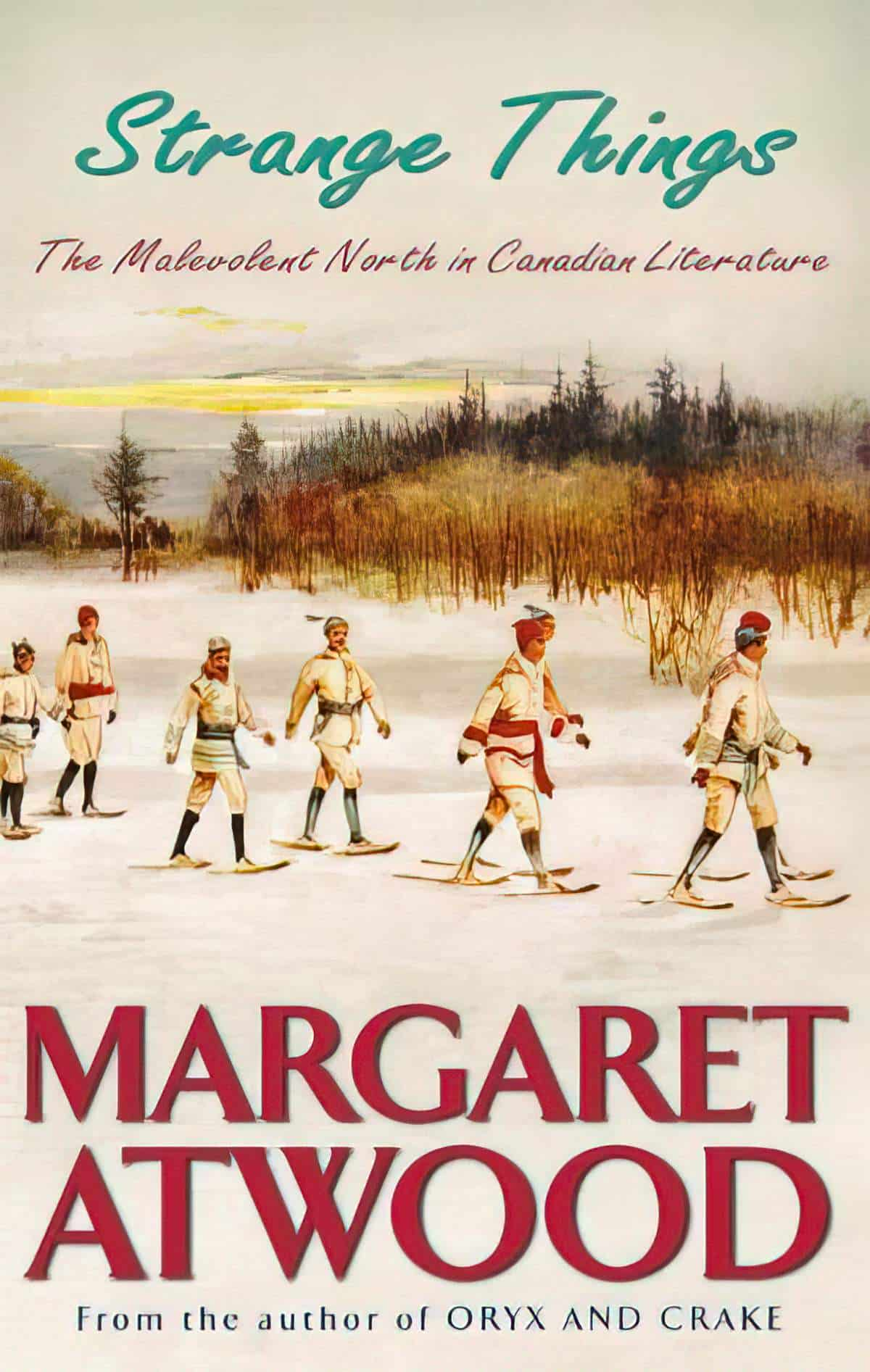
CHAPTER ONE: Concerning Franklin and his Gallant Crew
How did the North come to be thought of as a frigid but sparkling fin de siecle femme fatale, who entices and hypnotizes male protagonists and leads them to their doom?
CHAPTER TWO: The Grey Owl Syndrome
Grey Owl was a famous Native Canadian who, in the 1930s, almost single-handedly saved the beaver from being trapped in extinction in central Canada. He was also, in reality, an Englishman named Archie Belaney, who wore his assumed mask successfully until his death. Atwood writes about how some writers have attempted to see Native people and others have attempted to be Native people.
CHAPTER THREE: Eyes of Blood, Heart of Ice: The Wendigo
About the dreaded and overtly and voraciously cannibalistic snow-monster of the eastern boreal forest, which has appeared in many stories and poems, with many variations. What is a Wendigo, and what does it eat when it isn’t eating you? How can you avoid turning into one?
CHAPTER FOUR: Linoleum Caves
The title comes from a sentence in Alice Munro’s Lives of Girls and Women. This chapter is about ‘Women in the North Stories’ and how the kitchen can be more dangerous for women than the wilderness. Imagery of the North has been built-up by male writers. What happens when women tackle it? If the North is a femme fatale, is the Northern wilderness as tough on women as it is on men? Is it possible to make love with a bear?
In the first chapter, Atwood considers the meaning of Canada’s ‘up north’:
- a mappable place, but with shifting boundaries
- a state of mind
- wilderness, frontier
- a place with Mounties (and their barking dogs), pursuing madmen through snow, ‘prospectors stumble raving out of the bush clutching their little bags of gold-dust, jolly vogaguers rollick in their canoes, Indians rescue hapless whites who get endlessly lost in the woods, wolves devour lone hunters… Eskimoes”
This imagery is utilised by politicians and cartoonists, Miss Universe contestants, in picture postcards etc. Everyone understands the imagery of the North. When the North is evoked in literature, it gets a little more complicated.
The American counterpart of England’s Oop North is Ap Nort, which is a parody of the dialect spoken in the Twin Cities.
Alaska
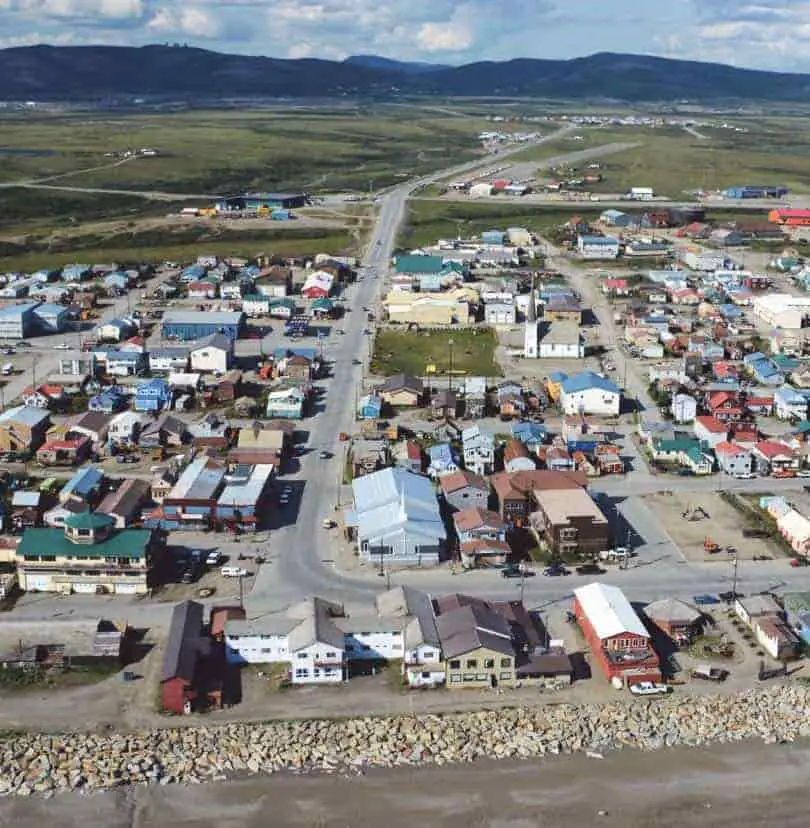
But the real American north is Alaska, America’s modern frontier. It is by far the least densely populated state of America.
Most people who live there aren’t actually born in Alaska. (Only about 40 per cent of Alaskan residents were born there.) It’s considered a place where people travel to, or escape to. Much of Alaska’s population is transitory.
Useful Notes On Alaska from TV Tropes.
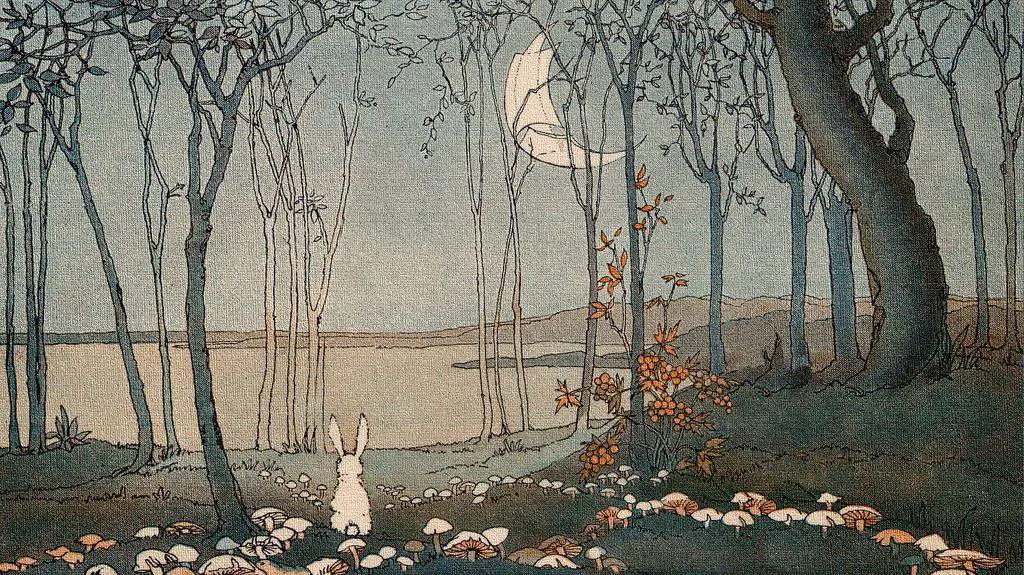
In children’s literature, Alaska is where the Cullens go to hunt in Twilight. Jack London’s stories were set in Alaska, as was Julie of the Wolves. In all three cases, there is hunting and wilderness. The northern environment brings wildness out of the characters.
SYMBOLISM OF THE EAST
He stopped and looked down at [the deer]. The feathers of the arrow protruded from just in back of the shoulder. The arrow had gone through the heart. She had died with her head to the east, which was good, and Russel found some of the sweet tundra grass the caribou liked and put it in her mouth.
Dogsong by Gary Paulsen, p47
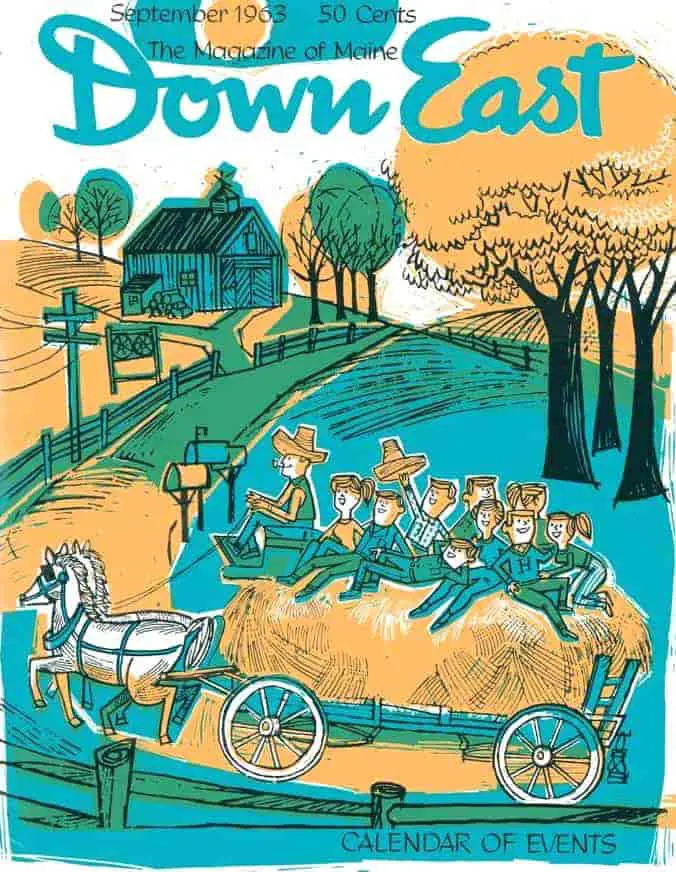
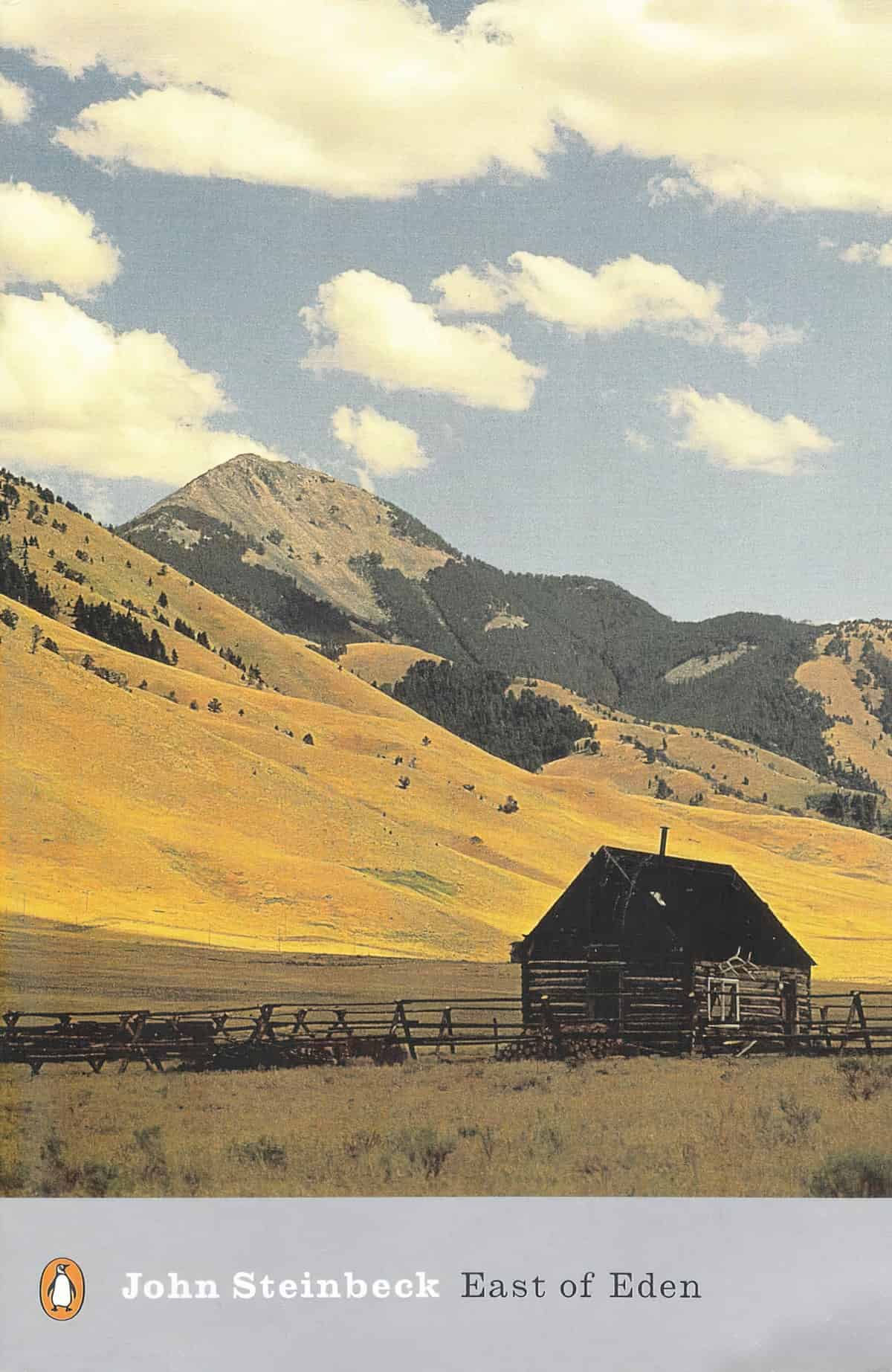
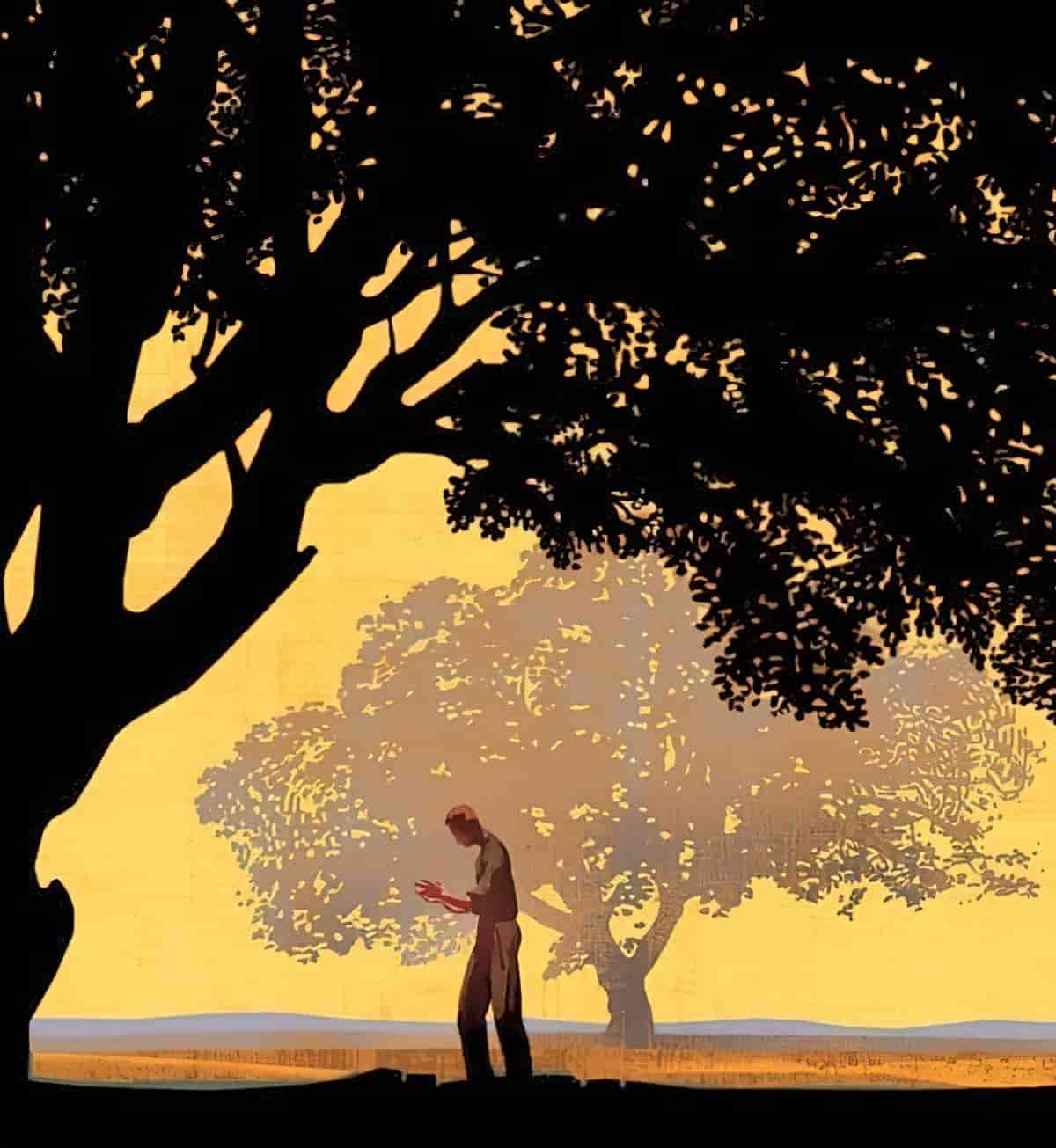
The Sun rises in the East everywhere on Earth. Sometimes a little north of east, sometimes a little south of east, but always east. It’s likely that the word East came from a word that means ‘shining’.
East = Beginnings. Because that’s where the new day begins. Metaphorically, east = an awakening, vision, ascension.
In the ancient world, the point of orientation was east. The east was before them, the west behind, the south to the right, and the north to the left.
This convention has been completely inverted in a modern (20th century) Western-style picture book such as Wheel on the Chimney. When Tibor Gigely illustrated Margaret Wise Brown’s story about the Southern European tradition of affixing cartwheels to chimneys in the hope that they’d nest there and bring your family good luck, Gigely depicted the storks flying ‘West’ (backwards) through the book as the storks flew South to migrate. In this way, Gigely subtly linked ‘West’, ‘left’ and ‘South’.
The importance of the east as the main point of orientation may be related to the rising of the sun and its importance in the religions of the ancient Near East. In the Bible, the East’s symbolism emerges for the first time in Genesis. The Garden of Eden was placed in the East and its entrance faced east.
After sinning, Adam and Eve left the garden and went east.
This eastward movement continued with Cain and culminated in the movement of the human race toward the east.
That said, the east is symbolically ambivalent. The garden placed there symbolized safety and security. After sin, when it was the direction of the exile, it represented a condition of alienation from God. It was also the place of the wilderness Destructive winds came from the east, threatening life.
To the prophets, the east was a symbol of Babylonian exile and the saving presence of God. God travelled to Babylon and ultimately redeemed his people. The east became a place where God intervened, bringing them salvation.
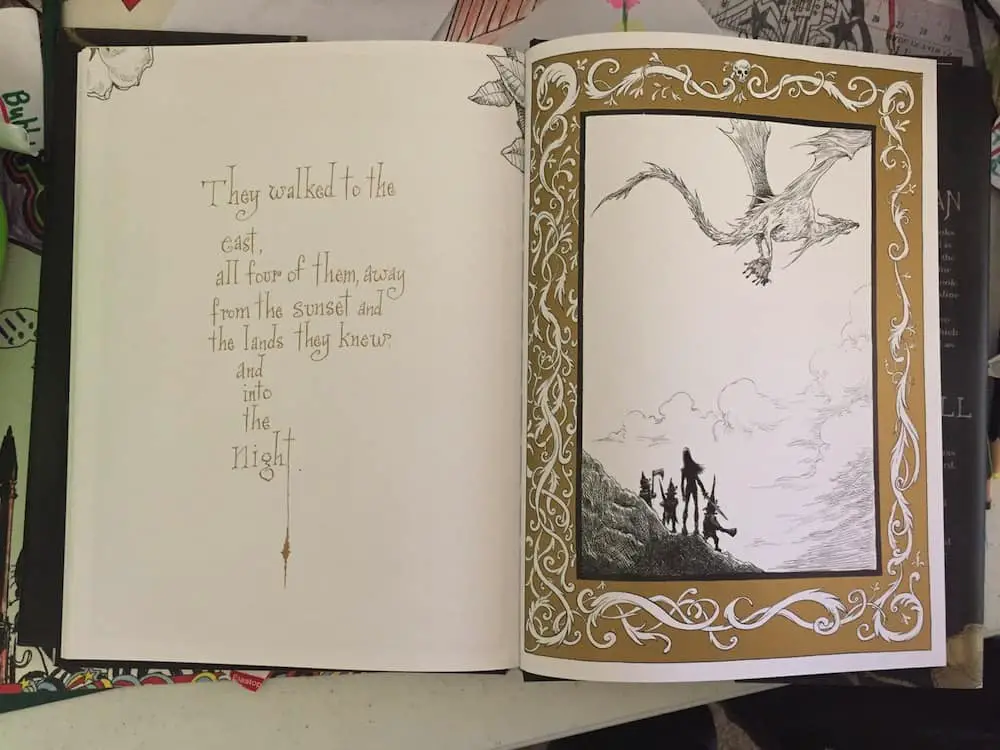
Hordes From The East
“The East” comes from the typical placement of the “others” in Real Life Western Europe. The usual candidates for the hordes include Mongols, Muslims, Huns, Hungarians, Scythians, or Russians, or Fantasy Counterpart Cultures of them. Like several of these cultures, they’re likely to have been Born in the Saddle. They’ll sometimes look stereotypically Asian, but they aren’t criminal masterminds like the Yellow Peril – they’re just a mass of Mooks born to be mooks. A culture can even be on both sides of the trope.
Russians are a source of Hordes for Western Europe, but they themselves endured Mongol control for some centuries – it’s a popular trope in Russian folk tales. The Hordes from the East will often act like The Horde, but they don’t have to. Hordes from the East will always be presented as a feared foreign danger, but their behaviour can vary. There’s a chance that they don’t pillage at all, or that they use clever strategies in big struggle instead of just brute force.
Some cultures have their own tropes involving attacks from a particular direction. For example, an attack would have always come from the North/West in China, from the North-West in India, and from the North in Rome. Another variant is to have hordes from up north, Vikings or Norse barbarians.
TV Tropes
The East vs West In America
New York and New Orleans have symbolic significance as “gateways” to America. Most of our American forefathers entered the new world of America through the eastern gateway of New York and then entered into the heart of America through the southern gateway of New Orleans. In this sense, one could say that New York represents the gateway to America while New Orleans represents the gateway to the “heart” of America. True to general east-west American symbolism, the cities of the east represent the old and traditional values of America while those of the west represent the new.
Symbolism of Place
The Wizard Of Oz/Wicked—Case Study
Since Elphaba is The Wicked Witch Of The West, why did Maguire choose to have her born in the East? Elphaba gradually makes her way West over the course of Wicked.
Did Maguire make use of the symbolism Biblically associated with cardinal directions? I believe the author is influenced by directions as portrayed in Judeo-Christian thinking:
The sun rises in the east. It makes sense that in a work of fantasy, because East = birth. The Garden Of Eden was in the East. And remember, it was only after Adam and Eve left Eden that everything turned terrible for us humans, according to the Bible.
In the Bible false kings come from the North. This is where Elphaba goes to university. Though she was presumably ostracised at school, too, this is where we see it. She is frozen out of Galinda’s social circle, relegated to the lunch-table with the Munchkin (the beta-male). Since most of the world lives in the Northern Hemisphere, the North is seen as cold. In Wicked, North is emotionally cold.
The West is also the place of darkness because that’s where the sun sets. In other words, the West symbolises a green girl’s descent into evil.
Through Wicked, Maguire narrates the story of the Wicked Witch of the West, and her life and experiences in Oz — which is not a fairytale place of happiness and joy, but a dark, oppressive police state full of political machinations. It’s a land where Animals, who are sentient and have voices, souls and minds, are persecuted and exiled. It’s a place where you are wicked if you are different; if you tell the truth.
[…]
Oz’ politics is as complex and often as ludicrous as it is in our world. The same is true of Oz’ religions and belief systems. The religion of the Un-named God, the pleasure-seekers, the followers of the time dragon, education, the different social and political causes — each has its zealous followers who have their own tenets of Right and Wrong, about Good and Evil.
Inkscrawl
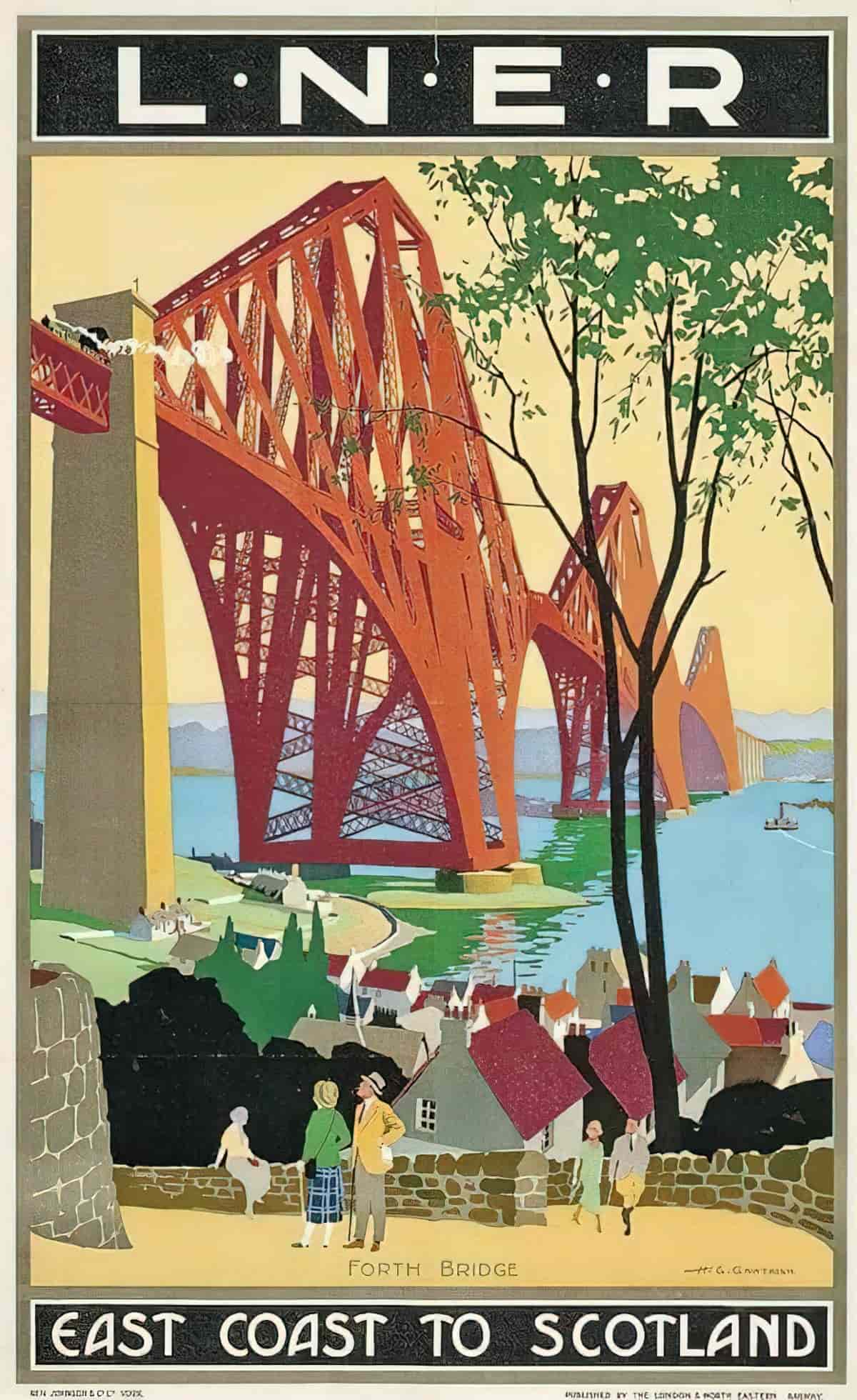
THE SYMBOLISM OF THE SOUTH
So, we know the sun always travels from east to west. In the Northern Hemisphere, the sun travels east to west in the southern half of the sky. For this reason, many words for South across cultures connect to where the sun is located at a mid point in its trip from east to west. In several languages, the word for ‘south’ is the same as the word for ‘midday’. In other languages, the word for south means ‘where the sun is at midday’. (e.g. Hungarian, Polish, Latvian languages.)
In some languages, ‘house’ and ‘south’ are connected. The ‘house’ of the sun refers to where the sun lives, i.e. the Southern Sky in its entirety. (For another use, see the folk song popularised by The Animals in 1964: “House of the Rising Sun”.)
“Going Down South” by R.L. Burnside (YouTube)
Okay, so here’s the general rule: whether it’s Italy or Greece or Africa or Malaysia or Vietnam, when writers send characters south, it’s so they can run amok. The effects can be tragic or comic, but they generally follow the same pattern. We might add, if we’re being generous, that they run amok because they are having direct, raw encounters with the subconscious.
Thomas C. Foster, How To Read Literature Like A Professor
This tracks with the history of white settlers sent to Australia. Most passengers on the first fleet were designated criminals, the first larrikins of colonial Australia. Send em south! They won’t bother us way down there.
In the passage above, Foster makes reference to:
- Lawrence’s searchers
- Hemingway’s hunters
- Kerouac’s hipsters
- Paul Bowles’s down-and-outers and seekers
- Forster’s tourists
- Durrell’s libertines
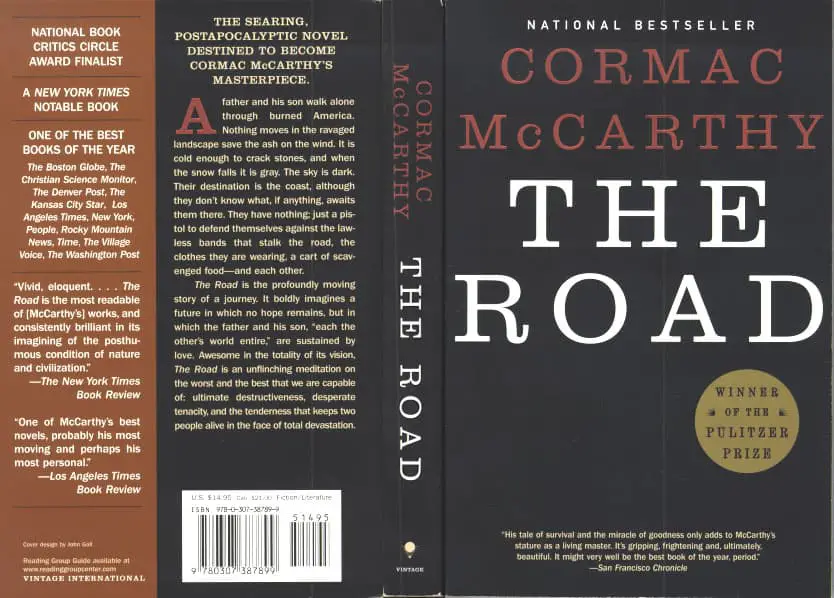
South derives from a word meaning sun, alluding to warmer parts of the world.
Biblically, the south is primarily a negative symbol. It is negative because to the south of Israel was the wilderness, a region where life does not prosper.
To the south was Egypt, which opposed God’s power and oppressed His people. But the south was also the place where the Lord appeared to Moses, went with Him to Egypt, liberated His people, and appeared to them on Mount Sinai.
But the fact that it is represented by the right hand makes it also a positive one.
The American South
The Savage South
If you thought the north was bad, you haven’t seen the south. Down there, everyone is crude, their language indecipherable and their mannerisms are barbaric. The land is an inhospitable jungle full of wild beasts, barren desert, or nasty swamps full of crocodiles (sometimes it has all of the above). Also, don’t go swimming: there are sharks, or worse.
The Savage South is when a southern area is seen as more barbaric than its northern counterpart. This shows up frequently in westerns, fantasy settings, horror films, and many other works and takes many forms. In milder versions, the area’s just unpleasant with rude, poorly groomed people. At worst, the people are hostile to any outsiders and the land itself is a nightmare realm just waiting to kill unlucky travellers.
TV Tropes
The Deep South
The Deep South: home of fat redneck sheriffs, hillbillies, moonshiners, The Klan, tobacco-chawin’ Good Ol’ Boys missing half their teeth, and all other manner of Corrupt Hicks, not to mention fire-and-brimstone preachers, iron-bound matriarchs, white-suited plantation owners, Southern Belles in flouncy gowns or short-shorts with crop tops, and possums. Some Kissing Cousins could also be in the mix somewhere.
Although the real mid-Southern and Southeastern United States has a far wider range of locales and settings, the Deep South as it appears on TV is usually one tiny rural town after another, separated by miles of farmland or steep, forested mountainsides. Its inhabitants always seem to be about fifty years behind the times, at least as far as social issues are concerned
TV Tropes
(If the South is looking decayed, misty and/or possibly undead, then it’s Southern Gothic instead.)
THE SYMBOLISM OF THE WEST
- The West — in American writing The West means two things: The Western part of the USA and also the New World
- The American West — the Western part of the USA is used as a synecdoche in American literature of the New World. (Synecdoche: a part is made to represent the whole, or vice versa.)
- The New World — the so-called ‘western hemisphere’, but especially the continental landmass of North and South America. Here in Australia we consider ourselves part of ‘The West’ even though we’re nowhere near the American continents. Generally, the list of countries considered part of the old world are: Italy, France, Spain, Portugal, and Germany. Countries considered part of the New World are USA, Canada, Argentina, Chile, South Africa, Australia, and New Zealand. This is because Europeans didn’t make it to these parts of the world until the late 15th century. Of course, the New World is a Eurocentric label.
To be sure, the European mind had dreamed for centuries before the Enlightenment of an absolute West: Atlantis, Ultima Thule, the Western Isles–a place of refuge beyond the seas, to which the hero retreats to await rebirth, a source of new life in the direction of the setting sun which seems to stand for death. Dante, however, on the very brink of an age which was to turn the dream into the actualities of exploration, had prophetically sent to destruction in the West, Ulysses, the archetypal explorer. The direction of his westward journey through the great sea is identified with the sinister left hand; and Ulysses himself comes to stand for man’s refusal to accept the simple limits of traditional duty; “not the sweetness of having a son, nor the pious claim of an old father, nor the licit love that should have made Penelope rejoice could quench in me the burning to become familiar with the vice of men and men’s valor.” It is a fitting enough epigraph to represent that lust for experience which made America. There is, indeed, something blasphemous in the very act by which America was established, a gesture of defiance that began with the symbolic breaching of the pillars of Hercules, long considered the divine signs of limit.
Leslie Fiedler, “The Novel and America”, A Fiedler Reader, 1977
In a number of languages, the word for west connects to the word for back, back part, behind. (And the word for east connects to front, front part, in front of.) Whereas East is very occasionally associated with the concept of ‘back’, West never means front. For humans, across cultures, facing east is ‘the canonical posture’, the natural basis for orientation.
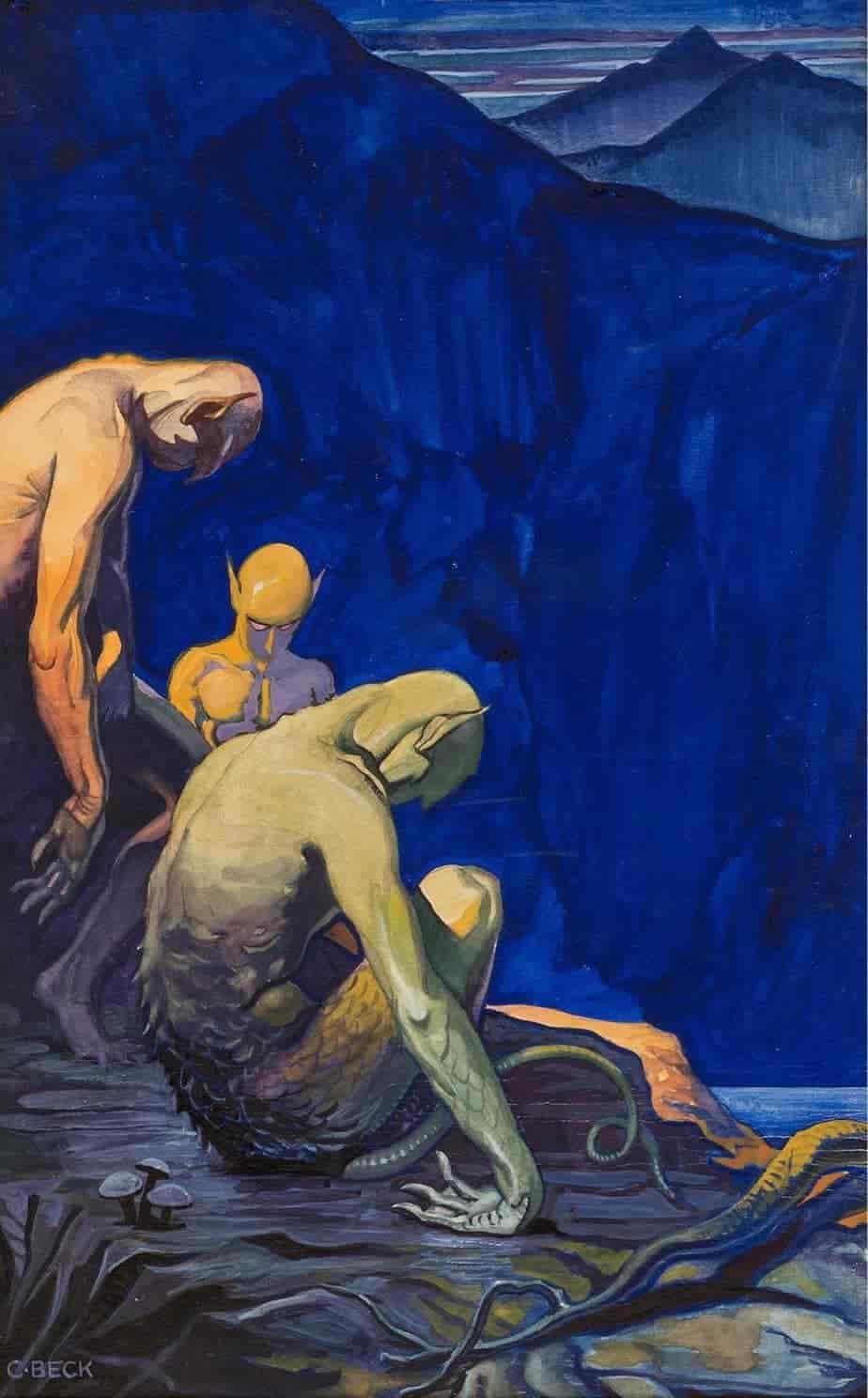
The word for West likely comes from another word meaning ‘to go down’.
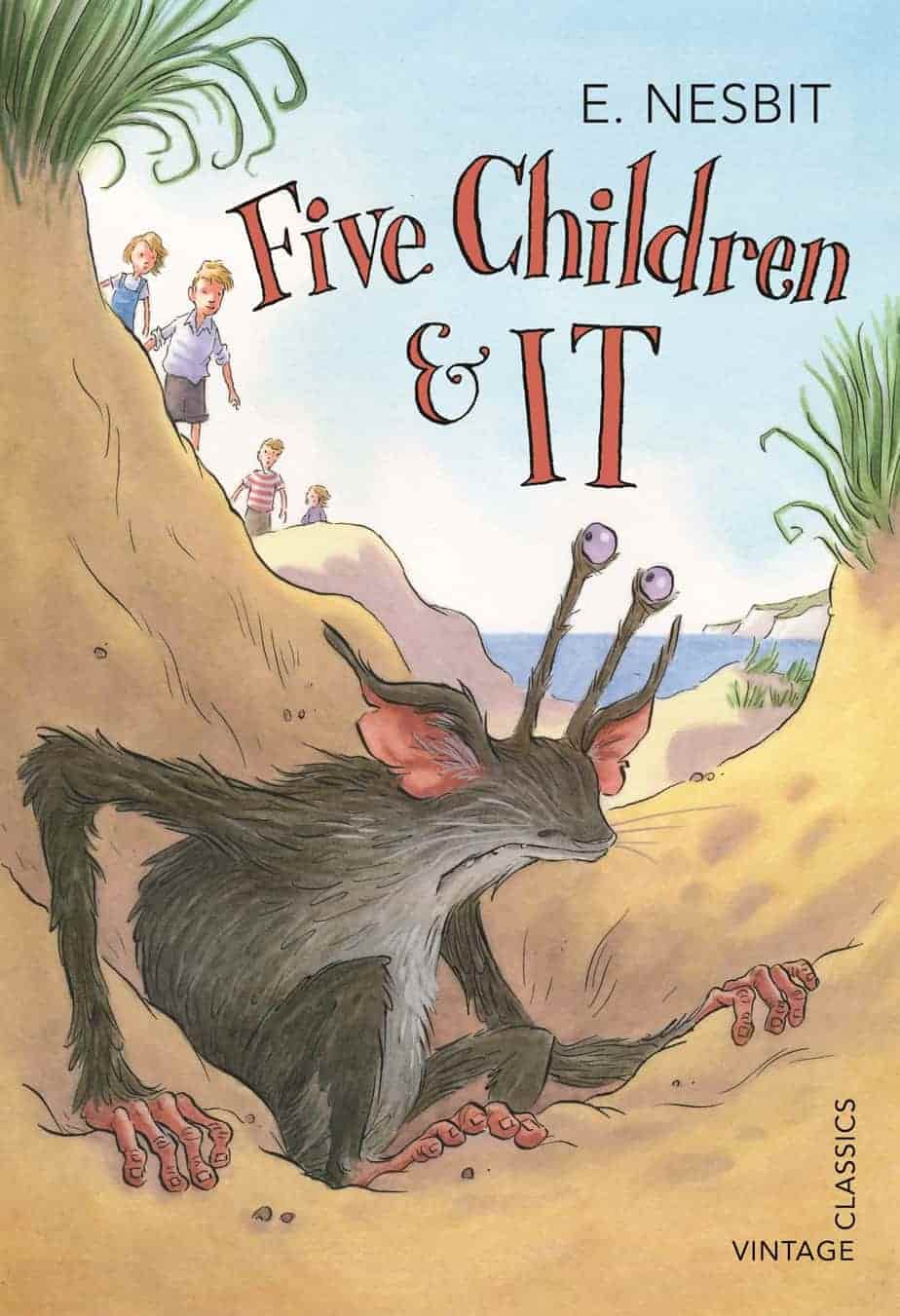
Edith Nesbit must have been a stickler for detail when she wrote:
And the sun was sinking slowly in the west. (I must say it was in the west, because it is usual in books to say so, for fear careless people should think it was setting in the east. In point of fact, it was not exactly in the west either – but that’s near enough.)
E. Nesbit, Five Children and It
(In New Zealand, where I come from, the sun rises in the East but sets more in the North.)
According to the Bible, the Israelites crossed the Jordan River westward into the Promised Land. Note that the sea lies to the West. In fact, in the Bible, the term “sea” often referred to the west.
The West is also the place of darkness because that’s where the sun sets.
West = evil and death.
But the West also pointed toward restored unity with God — a return to the Garden of Eden. For example, when the Israelites traveled to and worshipped in the Temple they faced West to have the rising sun behind them.
King Arthur
King Arthur stories are hugely influential, even if you’ve never read any actual King Arthur stories. Upon his release, Joseph gathers his in-laws and other followers and travels to the west and founds a dynasty of Grail keepers that eventually includes Perceval.
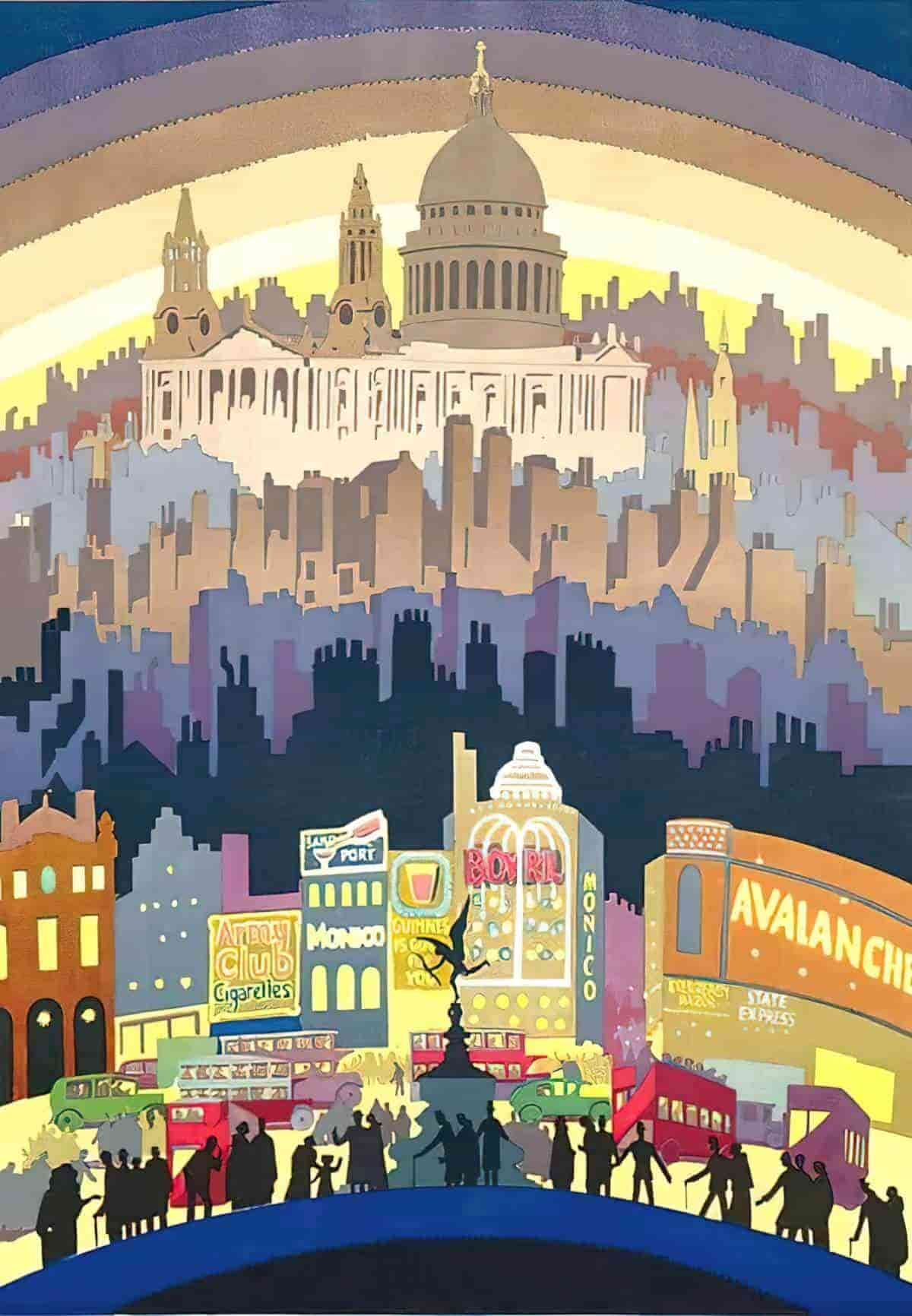
In America: The Western Genre and ‘Manifest Destiny’
Manifest destiny is the 19th-century belief that the expansion of the United States throughout the American continents was both justified and inevitable.
Connected to the myth of the West and the American Dream: the old idea of Manifest Destiny can excuse imperialism and interventionist foreign policy.
The Theme Park Version of the old west is a land of Indians, grizzled prospectors, scenic bluffs, Conestoga wagons, tough, shotgun-toting pioneers and buxom, be-feathered dance-hall girls. Also home to very lucrative sugar glass and balsa-wood chair industries, judging by the number of bar brawls which occur during a single episode of a typical western series. Bad guys and anti-heroes wear black hats, good guys and sheriffs wear white hats, shootouts on Main Street occur with the frequency of at least one an hour—with the sun at high noon each time—and everyone drinks sarsaparilla or whiskey.
The real Old West was nothing like The Theme Park Version (which was originally the creation of 19th-century “dime novels”). There weren’t any huge shootouts, quickdraw duels were rare, and gun duels and violent gun-wielding criminals weren’t exclusive to desert-like “western” areas. Plus, since many guns were very inaccurate in those days, they sometimes tended to happen in significantly closer quarters than they do in fiction.
TV Tropes, The Western
I was entering a land of drifters: dreamers, losers, vagrants, crazy people – they all always go west in America. They all have this hopeless idea that they will get to the coast and make a fortune as a movie star or rock musician or game show contestant or something. And if things don’t work out they can always become a serial murderer. It’s strange that no-one ever goes east, that you never encounter anyone hitch-hiking to New York in pursuit of some wild and crazy dream to be a certified public accountant or make a killing in leveraged buy-outs.
Bill Bryson, The Lost Continent
EAST AND WEST SYMBOLISM IN THE GREAT GATSBY
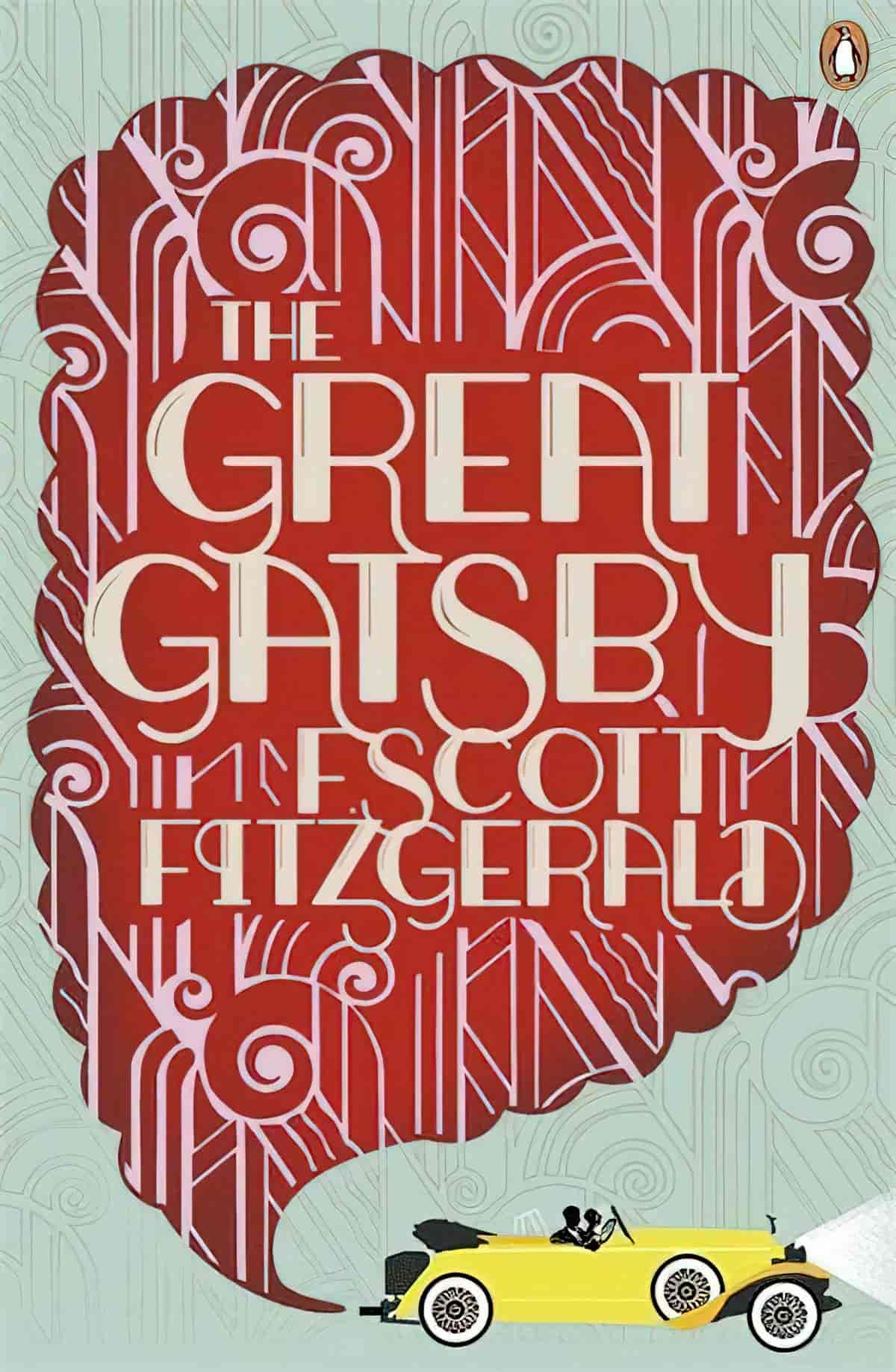
The Great Gatsby is a 1925 novel by American writer F. Scott Fitzgerald. Set in the Jazz Age on Long Island, near New York City, the novel depicts first-person narrator Nick Carraway’s interactions with mysterious millionaire Jay Gatsby and Gatsby’s obsession to reunite with his former lover, Daisy Buchanan.
Wikipedia
In American literature (e.g. in The Great Gatsby) moving West has sometimes symbolized gaining freedom, perhaps as an association with the settling of the Old West (see also Manifest Destiny).
Wikipedia
Edwin Fussell highlighted the symbolic meaning of this apparently casual sentence: “I am inclined to think Fitzgerald knew what he was about when he called The Great Gatsby ‘a story of the West’. Traditionally in American writing ‘the West’ means both the Western part of the United States and the New World, and especially the first as synecdoche of the other”. … Though the West has typically been seen as a land of promise and possibility, as the symbol of American ideals, Tom and Daisy travel East instead, representing a betrayal of the democratic ideals associated with their country by perpetuating a rigid class structure that excludes newcomers like Gatsby. The East in The Great Gatsby becomes, then, a symbol of the corruption of Americna values, a place that attracts people from the West because of its glamour and sophistication, but that has “a quality of distortion” (Fitzgerald). Since it is a place where material gain is the only thing that matters, people like Tom, Daisy and Jordan become corrupted, selfish and “careless”. As Robert Ornstein said, “the lure of the East represents a profound displacement of the American [D]ream, a turning back upon itself of the historic pilgrimage towards the frontier which had, in fact, created and sustained that dream.
In contrast, the West represents the moral roots to which Nick returns in the end, summarized by the advice his father gives him at the beginning of the novel: “Whenever you feel like criticizing anyone … just remember that all the people in this world haven’t had the advantages that you’ve had. But the West is also, and fundamentally, associated with Gatsby’s dream, which Fitzgerald equates with the American Dream of the first settlers, through the identification between the “green light at the end of Daisy’s dock” and the “green breast of the new world” which the first settlers would see on their journey westward towards their desired destination […]
Fitzgerald reinforces these associations with the location of his characters’ houses in Long Island: Gatsby and Nick (who represent the real values of the West) live in West Egg (Great Neck in reality), whereas Tom and Daisy (the careless Westerners corrupted by the East) live in East Egg (Manhasset Neck).
González, Jesús Ángel. “Eastern and Western Promises in Jonathan Franzen’s ‘Freedom’ / Promesas Del Este y Del Oeste En ‘Freedom’, de Jonathan Franzen.” Atlantis, vol. 37, no. 1, 2015, pp. 11–29
Very similar symbolism is used by Jonathan Franzen in his novel Freedom. Patty travels West to St. Paul to escape from the corrupted East. When she and Walter eventually go East, they are disappointed. This is a displacement of the American Dream, bringing both moral and personal failure.
What is ‘Manifest Destiny?’
In the 19th century, manifest destiny was a widely held belief in the United States that its settlers were destined to expand across North America.
In popular children’s literature, manifest destiny can be seen most clearly in Little House On The Prairie by Laura Ingalls Wilder. In adult storytelling, the entire genre of Westerns are about expansion and manifest destiny, though we’ve hardly seen a single straight Western since the second world war. (Modern ‘Westerns’ are ‘anti-Westerns’.)
Anti-Westerns
In an Anti-Western the audience is encouraged to believe that expanding West is actually a grim and dangerous affair rather than a heroic one. The one exception is Shane, which is a straight Western, using all of the Western symbolism without irony.
Watch out for references to moving West when watching gangster films, too:
There are several gangster films in which a member of the gang says he’s got his eye on a farm or ranch out west, where he plans to get married and settle down. Anyone familiar with gangster films knows upon hearing this speech that this character will be dead before the story is over. Once you’re in the gang, you’re trapped, even if you’re its leader. Perhaps especially if you’re its leader.
Howard Suber, The Power of Film
Midwestern Values
These days you get a lot of American stories set somewhere in the non-specific ‘mid-west’ — and that’s all we need to know about the place. For those of us who are not American, what does this mean, exactly?
What are Midwestern Values? is a question asked and answered on Quora.
Westerns and Children’s Literature
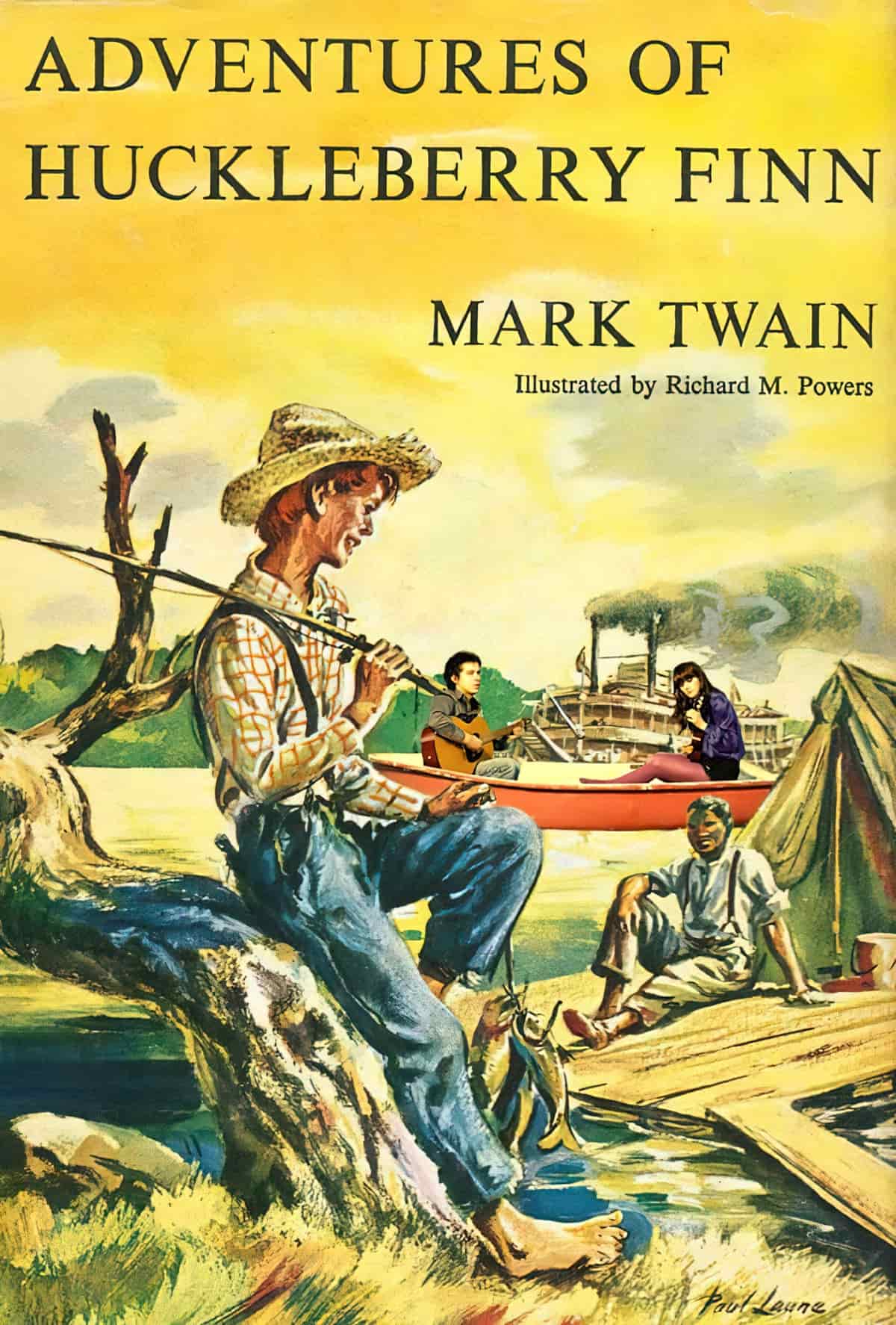
When it comes to Westerns and children’s literature, there was nothing for children at the time. Nothing excellent, anyway. Tom Sawyer and Huckleberry Finn came along and changed that. (At the end of Huck Finn, Huck declares that he is quite glad to be done writing his story, and despite Sally’s plans to adopt and civilize him, he intends to flee west to Indian Territory.)
Weird West — A New Genre
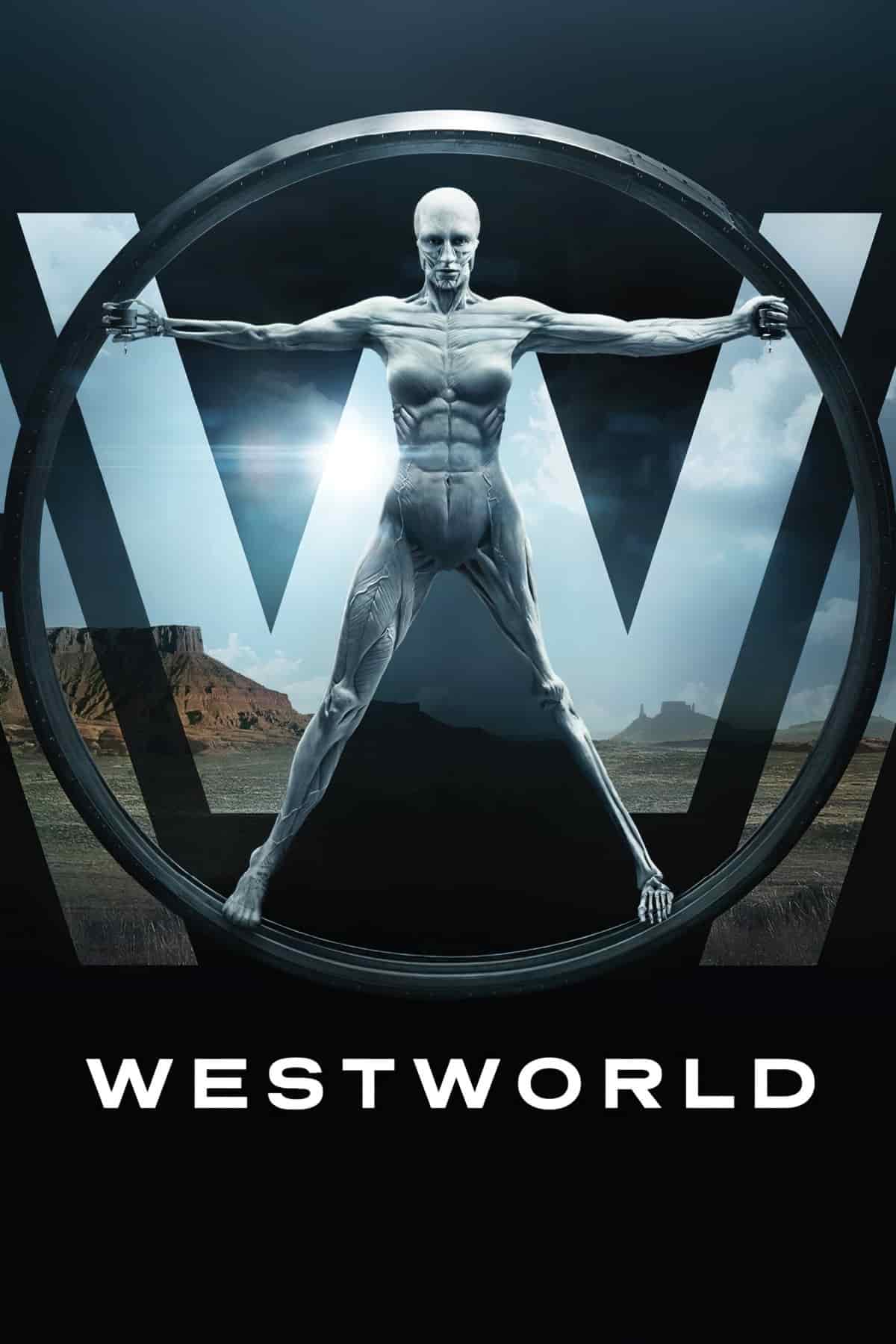
Weird West is a type of urban fantasy. It uses lots of Western tropes but makes use of magical realism/supernatural features. Westworld is a great example of Weird West.
For more see: Why The Weird West Works
For anyone interested in literature from Western Australia in particular, more here, from The Book Show.
EVANGELISTS’ SYMBOLS
In the Bible, the four evangelists were Matthew, Mark, Luke and John. These guys were disciples of Christ who witnessed and wrote about events in the life of the Messiah. They are often presented as hybrid creatures rather than as men.
Each of these men corresponds to a different cardinal direction, as well as to the elements, the winds, the “astrological point” and the four rivers supposed to run through Eden. (Each one also gets his own sign of the zodiac.) All together, Matthew, Mark, Luke and John symbolise stability and the four pillars of the faith. This symbolism comes from Mesopotamian mythology.
Header illustration: The Story of the Weathercock by Evelyn Sharpe 1907 illustrated by Charles Robinson
